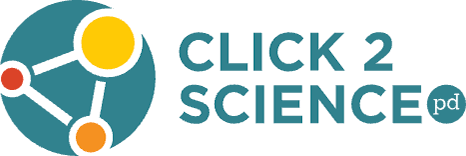
Teaching STEM
User Pathways
Click2Science User Pathways are designed to support personal learning and developing your skills in teaching STEM in out-of-school time programs.
Planning STEM Learning Experiences
Find strategies for selecting STEM activities, preparing yourself, gathering materials, setting up the space and managing the group.
View PathwayBasics of Teaching STEM
Learn the basics of STEM teaching – strategies for asking great questions, keeping groups focused and productive, making meaningful connections and assessing what was learned.
View PathwayEngaging Youth
Develop strategies for leading fun and engaging experiences – encouraging collaboration, connecting to prior experiences and giving youth control of their own learning.
View PathwayBuilding STEM Identites
Prepare young people for a STEM future – helping them use STEM practices, develop their identity and make their own connections to careers that use STEM.
View Pathway
Skill: Supporting Documentation of STEM Learning
Take Note! Supporting Documentation of STEM Learning
Documenting learning can be a burden at times, especially in an active out-of-school-time setting where children are coming and going throughout the program time. Yet showing evidence of learning may be the lifeline to a program’s funding and survival. In this module, review practical examples of the “why,” “what,” and “how” of STEM processes documentation.
Learn MoreSkill: Connecting to Prior Knowledge & Experiences
Sparking Interest in STEM
Learn how to foster interest, wonder and excitement in STEM. Make plans for incorporating specific sparking ideas into your programming with youth. Be prepared to spark children’s interests and maintaining their participation in STEM investigations. This lesson includes a variety of experiences, handouts and videos to enhance your learning.
Learn MoreSkill: Preparing STEM Learning Opportunities
Selecting STEM Activities
This lesson features interactive experiences and handouts that help you know how to select STEM activities to meet the interests and developmental levels of youth, providing STEM learning opportunities for youth and staff, and finding activity resources.
Learn MoreSkill: Preparing STEM Learning Opportunities
Preparing Yourself to Facilitate STEM
Out-of-school programs have a unique opportunity to impact the STEM skills of youth. This module features interactive experiences, handouts and videos to help you prepare to lead STEM experiences.
Learn MoreSkill: Modeling Science Practices
Modeling Science and Engineering Practices
Asking questions, trying ideas, and seeing how things work–that’s what scientific inquiry is all about. Learn how you can support youth in this process by modeling STEM practices. This web lesson includes video examples and downloadable resources to equip the provider in this coaching role.
Learn MoreSkill: Reflecting & Processing Experiences
Minds-On Learning – Reflecting and Processing in STEM
Even when you know how to create engaging activities for youth, you may struggle with the process of reflecting on STEM activities to make a more meaningful learning experience. This web lesson includes several STEM experiences that will let you practice how to process science learning.
Learn MoreSkill: Creating STEM Learning Environments
Maximizing STEM Space
How you arrange the environment can impact the way youth engage and experience science, engineering, and math learning in an out-of-school time program. Learn how to set up space and arrange materials to maximize youth involvement.
Learn MoreSkill: Making Authentic Assessments
Making Authentic Assessments of STEM Learning
Assessment is an essential but often overlooked part of STEM learning in after school programs. This web lesson features interactive experiences and resources to help you develop the skills to include authentic assessment of youth STEM learning experiences.
Learn MoreSkill: Encouraging Collaborative STEM Work
It Takes Two! Encouraging Collaborative STEM Work
Scientists and engineers work together to solve problems. In this web lesson, you will learn how to emphasize teamwork in STEM experiences. Practitioners share tips on projects, environment set-up, and group management that encourage cooperative learning. Easy-to-download instructions for several STEM challenges are provided.
Learn More
Skill: Modeling Engineering Practices
Soda Straw Rockets
Build an air powered rocket and test how different factors affect the flight of your soda straw rocket.
Get ActivitySkill: Modeling Science Practices
What Lives Under That Dead Tree
Use the scientific practices of ecologist to study the natural world around you. Look under a tree or rock and discover a whole new habitat.
Get ActivitySkill: Asking Purposeful Questions
Paper Circuits
Use simple materials to construct working circuits and think critically about the flow of electricity.
Get ActivitySkill: Creating STEM Learning Environments
Elephant Toothpaste
Explore the catalytic action created by the combining of yeast, hydrogen
peroxide and dishwashing liquid by making elephant toothpaste.
Skill: Managing Groups During STEM
Building Leaders in Out-of-School Time
We create space for listening, for curiosity, for solutions to grow from the conversation. The function of a good leader is not to single-handedly tackle everything, but to produce more leaders, not more followers.
Get ActivitySkill: Giving Youth Control
4-H Eco-Bot Challenge
Build and test an autonomous robot, called an Eco-Bot, to clean up a simulated environmental spill.
Get ActivitySkill: Asking Purposeful Questions
Water Filter
Practice using the engineering design process to design, build and test a water filter.
Get ActivitySkill: Modeling Science Practices
Exploring Soil Ecology
Use STEM practices to investigate what different soil samples are comprised of. Learn how different types of soil are used in different ways.
Get ActivitySkill: Reflecting & Processing Experiences
Wind Tunnel
Use the engineering design process to design, test, and redesign aerodynamic contraptions in a wind tunnel.
Get Activity